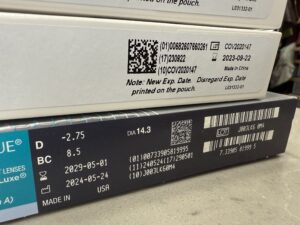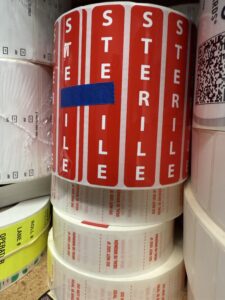The pharmaceutical and healthcare labeling landscape is undergoing a dramatic transformation in 2025. With technological innovation accelerating and regulatory frameworks evolving, manufacturers must stay ahead of these changes to maintain compliance while meeting consumer expectations. This handy guide will cover the most significant trends influencing healthcare labels, pharmaceutical labels, nutraceutical labels, and custom labels this year.
Smart Technology Integration in Healthcare and Pharmaceutical Labels
QR Codes and NFC Technology Revolutionizing Medication Information
Smart labels have moved beyond basic identification. Today’s pharmaceutical industry incorporates QR code labels and Near Field Communication (NFC) tags that connect patients to interactive instructions, dosage videos, and real-time updates. Major pharmaceutical companies report up to 40% improvement in patient understanding when using these interactive elements.
“The static label has evolved into an information gateway,” notes Dr. Sarah Chen, pharmaceutical packaging specialist. “A single scan connects patients to everything from proper storage conditions to potential drug interactions.”

RFID Technology for Supply Chain Visibility
Radio-frequency identification (RFID) tags embedded in healthcare labels now track medications from manufacturing to patient delivery. This technology prevents counterfeit products from entering the supply chain while ensuring temperature-sensitive medications maintain their efficacy.
For healthcare providers, these smart labels provide traceability for instant verification of authenticity and expiration dates with a simple scan, reducing medication errors and improving patient safety.
Regulatory Compliance and Security Features
Global Harmonization of Pharmaceutical Labeling Standards
The International Council for Harmonisation (ICH) guidelines have finally achieved substantive global adoption in 2025, creating consistency across markets. This standardization reduces the complexity of managing multiple label versions, particularly valuable for companies distributing products internationally.
Healthcare labels now feature universally recognized iconography, standardized warning systems, and consistent information hierarchies that transcend language barriers—a critical advancement for patient safety.

Track-and-Trace Requirements Expanding Worldwide
Serialization requirements once limited to North America and Europe now extend globally as regulatory standards. Pharmaceutical labels must incorporate unique identifiers that allow tracking throughout the distribution chain, with blockchain verification becoming standard practice for premium medications.
These security features protect both consumers and manufacturers, with counterfeit pharmaceutical incidents showing a 60% reduction where comprehensive tracking systems are implemented.
Sustainability Transforming Healthcare Labels
Biodegradable and Compostable Materials
Environmental consciousness has transformed pharmaceutical labeling materials. Plant-based adhesives, sugar cane-derived substrates, and water-soluble inks now meet stringent medical-grade requirements while reducing environmental impact.
Leading pharmaceutical companies have committed to 100% sustainable labeling by 2026, with many already transitioning their consumer-facing products to these materials in 2025.
Minimalist Design and Material Reduction
Digital information delivery has allowed physical labels to shrink without sacrificing information access. Regulatory agencies now accept streamlined physical labels paired with comprehensive digital resources, reducing material usage by up to 30% for some products. With the reduction in materials, this will offer alternative packaging solutions.
This approach particularly benefits nutraceutical labels, where clean design and sustainability align with consumer expectations for wellness products.
Patient-Centric Design Innovations
Accessibility Features for Diverse Patient Populations
Healthcare labels now routinely incorporate features for patients with visual impairments, including standardized tactile indicators, high-contrast text, and scannable codes that activate audio instructions. These trends in the pharma and healthcare packaging will greatly improve the user experience and their safety.
“The industry has finally recognized that accessible design isn’t optional—it’s essential,” explains accessibility consultant James Wong. “Universal design principles make medications safer for everyone, not just those with disabilities.”
Personalization Capabilities
Variable data printing technologies enable personalized dosing information directly on pharmaceutical labels. When integrated with healthcare systems, labels can include patient-specific warnings about potential interactions with current medications.
This personalization, while maintaining privacy compliance, significantly improves medication adherence rates and reduces adverse events.
Nutraceutical Labels Following Pharmaceutical Standards
Increased Scrutiny and Voluntary Adoption of Pharmaceutical Standards
The regulatory gap between pharmaceuticals and nutraceuticals continues to narrow. Forward-thinking companies now voluntarily adopt pharmaceutical-grade labeling standards, including third-party verification symbols and standardized ingredient listings.
This proactive approach builds consumer trust while preparing for anticipated regulatory changes in the coming years.
Transparency in Ingredient Sourcing
Nutraceutical labels increasingly feature QR codes connecting consumers to complete supply chain information. This transparency includes geographic sourcing details, extraction methods, and potency verification.
Brands that implement these transparency features report 45% higher consumer trust scores and increased repeat purchase rates compared to competitors using traditional labeling approaches.
Custom Labels Creating Competitive Advantage
Functional Packaging Elements Beyond Information
Pharmaceutical labels now incorporate functional elements that enhance medication safety and efficacy. These include:
- Temperature indicators that reveal if products have exceeded safe storage conditions
- Time-sensitive displays for reconstituted medications
- Patient compliance aids integrated into label design
- Antimicrobial coatings for high-touch packaging surfaces
Premium Aesthetics Meeting Functional Requirements
Healthcare doesn’t mean institutional anymore. Custom labels for premium pharmaceuticals and nutraceuticals balance elegant design with regulatory requirements, creating distinctive shelf presence without compromising information clarity.
Specialty finishes like soft-touch coatings and selective textures enhance the user experience while maintaining durability in clinical and pharma environments.
Looking Forward
With almost half way through 2025, the healthcare and pharmaceutical labeling landscape continues its rapid evolution. Manufacturers who embrace these innovations gain advantages in compliance, consumer trust, and operational efficiency. As we move through the second half of 2025, expect further integration between physical labels and digital information systems, creating an increasingly seamless experience for healthcare providers and patients alike.
For companies navigating these changes, partnering with label manufacturers specializing in healthcare and pharmaceutical applications ensures compliance while implementing these cutting-edge innovations.
Ready to speak with us? Let us show you how DSI Labels can assist with strategizing and design, all while reducing your labeling costs and improving efficiency. For companies that are located in the United States, contact our label specialists today 714-505-1270 for a consultation tailored to your specific product and brand needs.
